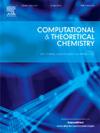Si(IV), Ge(IV), Sn(IV), Pb(IV)卟啉类化合物的分子和电子结构:dft研究
IF 3
3区 化学
Q3 CHEMISTRY, PHYSICAL
引用次数: 0
摘要
用DFT计算方法研究了卟啉配合物XPzY2 (X = Si(IV),Ge(IV),Sn(IV),Pb(IV), Y=F,Cl,Br,OH)的分子和电子结构。结果表明,Si和Ge配合物具有D4h对称结构,具有大环核的平面结构,轴向配体分布在大环核的两侧。与其他中心原子相比,铅的配合物由于其更高的离子半径而呈圆顶状扭曲,而在锡的情况下,构象偏好取决于轴向配体的性质。利用TDDFT计算计算了最低激发态。q带的位置受中心原子性质的影响较小,但轴向配体和大环核畸变的影响更为显著。此外,对卟啉类化合物与相应的卟啉类化合物的几何结构进行了比较,研究对象总数为32个分子。本文章由计算机程序翻译,如有差异,请以英文原文为准。

Molecular and electronic structure of Si(IV), Ge(IV), Sn(IV), Pb(IV) porphyrazines: DFT-study
The molecular and electronic structures of porphyrazine complexes XPzY2 (X = Si(IV),Ge(IV),Sn(IV),Pb(IV), Y=F,Cl,Br,OH) have been studied by DFT calculations. Geometries of complexes with Si and Ge were found to possess D4h symmetry with a planar structure of macrocyclic core and axial ligands located on different sides of it. The complexes with Pb are dome-shaped distorted due to its higher ionic radius compared to other central atoms considered, while in the case of tin conformational preferences depend on the axial ligand nature. The lowest excited electronic states have been calculated using the TDDFT calculations. The position of the Q-band is slightly affected by the nature of the central atom, but the influence of the axial ligand and the distortion of the macrocyclic core is more significant. In addition, a comparison of the geometric structure of porphyrazines with the corresponding porphyrins was carried out, thus the total number of objects studied was 32 molecules.
求助全文
通过发布文献求助,成功后即可免费获取论文全文。
去求助
来源期刊

Computational and Theoretical Chemistry
CHEMISTRY, PHYSICAL-
CiteScore
4.20
自引率
10.70%
发文量
331
审稿时长
31 days
期刊介绍:
Computational and Theoretical Chemistry publishes high quality, original reports of significance in computational and theoretical chemistry including those that deal with problems of structure, properties, energetics, weak interactions, reaction mechanisms, catalysis, and reaction rates involving atoms, molecules, clusters, surfaces, and bulk matter.
 求助内容:
求助内容: 应助结果提醒方式:
应助结果提醒方式:


